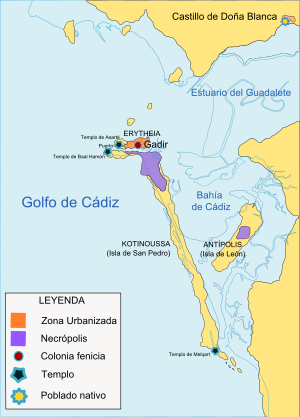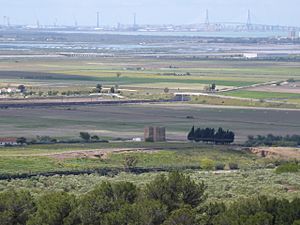Doña Blanca (archaeological site) facts for kids
36°37′38″N 6°09′40″W / 36.62722°N 6.16111°W
The Doña Blanca Archaeological Site is an amazing ancient place in El Puerto de Santa María, Spain. It's like a giant history book hidden underground! This special area covers about 200 hectares (that's like 500 football fields!). It has been protected as an important cultural site since 1991.
Contents
Discovering an Ancient City
This site is a tell. A tell is a hill made up of many layers of old buildings and things from different time periods. Archaeologists dug here between 1979 and 1995. They found parts of walls, homes, and a Punic river port. This port is the biggest one found in the Mediterranean Sea! They also found a burial ground, called a necropolis.
All these discoveries belong to an ancient Phoenician city. People lived here from the 8th to the 3rd century BC. This makes Doña Blanca one of the oldest Phoenician cities found in the Iberian Peninsula. It's super important for understanding how the Phoenicians settled in the western Mediterranean Sea.
What's really special is how well-preserved this city is. It's the only Phoenician city that has stayed mostly intact. This helps researchers learn about the Phoenicians in the Bay of Cadiz. It also shows how they interacted with local people. One amazing find is one of the oldest fully preserved wine cellars in the world!
The site also has the castle of Doña Blanca. It's a tower built in the 14th or 15th century. It was used to watch over the Bay of Cadiz. Some stories say Doña Blanca de Borbón was held captive here.
Exploring the Enclave of Doña Blanca
The enclave of Doña Blanca is just a small part of the larger Doña Blanca settlement. The whole protected area is huge, about 2 million square meters. It includes other important historical spots. These show how people lived in this area throughout history.
The oldest things found here are from the late Copper Age. That was around 3,000 BC. They found scattered huts from this time. Then, the site was empty for a long time. People moved back in around the middle of the 8th century BC.
By the 8th century BC, it became a real city with a strong wall. People lived here without stopping for 500 years! During this time, the city was rebuilt several times. Two more walls were added. The city was abandoned again around the end of the 3rd century BC. Later, in the medieval Islamic period (around the 12th century), an Almohad farm was built here.
Today, the Enclave is the only part of the Archaeological Site of Doña Blanca that you can visit. There's a circular path, about 1600 meters long. It takes you around the top of the hill to see different parts of the ancient city.
The Doña Blanca Tower
The Doña Blanca Tower is a small building shaped like a Greek cross. It was built in the late 15th century. Its main job was to be a watchtower for the bay and the Guadalete River. The tower you see today was rebuilt in the mid-1800s. It was in ruins after the Spanish War of Independence.
Some historians believe this tower is where Doña Blanca de Borbón was imprisoned and died in 1361. That's how it got its name! Other experts think it was a small church.
How the Landscape Changed
The area around the Sierra de San Cristobal looks very different today. It's not like it was when the first settlers arrived. One big change is that the bay has filled up with dirt and sand. This came from the Guadalete River. The land south of the site used to be sea! The river's mouth was much closer to El Portal.
Nature has changed over time due to weather and soil. But people have changed the land even more. They cut down trees, grazed animals, and farmed. So, today, you won't find the thick forests of cork oaks, carob trees, and pines that once covered these mountains.
Digging Through History
The first excavations started in 1979. They dug near the Tower entrance. The goal was to understand the history of the site layer by layer. Archaeologists dig deep into the ground. They record everything they find in each layer. They collect items that can help them understand and date the different periods.
In one area, they dug 9 meters deep! All those 9 meters were archaeological layers. These layers built up over the five centuries the city existed. So, the hill itself is artificial. It was created by all these layers of dirt and old buildings. In archaeology, these artificial hills are called a tell.
Homes from the 4th and 3rd Centuries BC
If you walk on the southern side, you'll see a large excavated area. It's about 1000 square meters. Here, you can see homes and buildings from the 4th and 3rd centuries BC. This shows us how the city was planned during that time.
The houses were built in neat blocks. They were arranged along wide, straight streets. One street found is about 36 meters long and 4 meters wide. It runs next to the city wall. The street floor was made of packed clay, broken pottery, and small stones.
The house walls had a stone base. Stronger calcarenite stones were sometimes used at corners and doorways. The floors inside were made of clay. Some areas, like courtyards, had stone floors. Near the homes, there were rooms with basins and ovens. These were used to make wine! This is the oldest wine cellar found in the West. This wine was special, probably only for important people. It was used in rituals for the deities.
You can also see parts of the city wall in this area. It has two parallel walls with smaller walls in between. These form small square rooms. Further south, you can see another section of this wall. It's made of well-cut ashlar stones of different sizes. They fit together perfectly. This type of wall building was common in other Punic defenses. Examples include walls in Cartagena and Carteia (San Roque). These date from the Barcid period.
Homes from the 8th Century BC
The oldest buildings, from the 8th century BC, are usually buried very deep. You have to dig about 7 to 9 meters down to find them. However, a large area outside the old city walls was found. Here, there were no later buildings on top. This allowed archaeologists to dig up a big section of these very old homes.
These homes were built on artificial terraces. They used the natural slope of the land. Each house had 3 or 4 square rooms. The walls had stone bases and mud-brick (adobe) tops. They were covered with clay and lime plaster. The floors were made of packed red clay. The roofs were flat or sloped, made with wooden beams and plants. Most houses had a bread oven. It was a round clay structure, about 1 meter wide at the bottom.
The Ancient Walls
As early as the 8th century BC, the city had a very strong wall. We only know a small part of it today. It was built directly on the natural ground. It used irregular stone blocks with red clay. In the excavated areas, it's still 3 meters high. Right in front of the wall, there was a moat. It was V-shaped, 20 meters wide, and 4 meters deep. This wall was used until the 5th century BC.
In the 5th century BC, the city got a new wall. It partly reused the old one. Finally, in the 4th-3rd century BC, the last wall was built.
The Necropolis (Burial Ground)
Across the Carrera de El Portal, near the Sierra de San Cristobal, is the necropolis. This is where the ancient people buried their dead. Archaeologists excavated a large burial mound, called a tumulus. It was about 20 meters wide and 1.80 meters high.
In the center was the ustrinum. This is where bodies were cremated (burned). Around it, there were 63 burials. They varied a lot. Some used urns of different types to hold the ashes. Others were simple holes dug in the ground for the same purpose.
Hidden Structures
In 2017, scientists used special tools like georadar. This helped them find more structures next to the ones already dug up. They don't plan to dig these up right now. Instead, they are thinking about using new technologies to share information about them. This would make visiting the site even more interesting!
What's Next for Doña Blanca
There's a project to improve the whole area. This includes the slopes of the Sierra de San Cristóbal and old military lands nearby. It's called "Tierras de Sidueña" (Sidueña Lands).
The government is also working to get Doña Blanca recognized as a UNESCO World Heritage Site. This would mean it's considered super important for everyone in the world!
See also
 In Spanish: Yacimiento arqueológico de Doña Blanca para niños
In Spanish: Yacimiento arqueológico de Doña Blanca para niños






